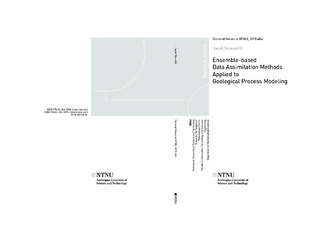| dc.contributor.advisor | Eidsvik, Jo | |
| dc.contributor.advisor | Omre, Karl Henning | |
| dc.contributor.author | Skauvold, Jacob | |
| dc.date.accessioned | 2019-01-18T08:21:36Z | |
| dc.date.available | 2019-01-18T08:21:36Z | |
| dc.date.issued | 2018 | |
| dc.identifier.isbn | 978-82-326-3599-3 ( | |
| dc.identifier.issn | 1503-8181 | |
| dc.identifier.uri | http://hdl.handle.net/11250/2581194 | |
| dc.description.abstract | Summary:
Data assimilation is the art of conditioning a numerical simulation of a physical process on observations of the real process. That is, adjusting estimates so that they agree not only with a mathematical model of reality, but also with direct measurements. Data assimilation is essential for a host of geophysical applications form circulation models of the atmosphere and oceans to weather forecasting and prediction of floods and droughts. Methods for data assimilation rely on a statistical description of a physical simulation model on the one hand, and of a data generating process on the other hand. Combining the information from these two sources in a consistent way leads to a compromise between theoretical simulation and empirical observation.
The actual state of a complex physical system, even an idealized and simplified one, is almost always underdetermined by data. Multiple possible states could have given rise to the same observations, so in practice the truth can never be uniquely determined. An ensemble, in this context, is a set of versions or realizations of the state of the simulated system. The realizations differ from each other by random variation, and the variation is intended to reflect the epistemic uncertainty associated with the actual system state. In ensemble-based data assimilation methods, an ensemble is formed by simulating each realization forward through time from an initial point to a later point. The ensemble is then compared with observations of the system at that point in time, and based on the comparison the ensemble is manipulated so that the distance to observations is reduced. Thus, information from data is assimilated into the statistical model.
The dissertation concerns the application of this type of method to a geologic process model, or more precisely a stratigraphic forward model, which simulates the formation of sedimentary rocks by deposition of sand, silt and clay. Usually there are no observations of this process unfolding. There may however be data related to the result, namely the finished sedimentary layer structure. An example of such data could be measurements taken at varying depths in a well drilled for petroleum exploration purposes. Since the sedimentary rocks are arranged chronologically, with older layers situated below younger layers, it is possible to start at the bottom and assimilate measurements of ever-younger layers while simultaneously simulating the sedimentation process forward through time. The result is a geologic simulation that is conditional on the available observations. | nb_NO |
| dc.description.abstract | Sammendrag:
Dataassimilering er kunsten å betinge en numerisk simulasjon av en fysisk prosess på observasjoner av den reelle prosessen. Det vil si å justere estimater slik at de er forenlige ikke bare med en matematisk modell av virkeligheten, men også med direkte målinger. Dataassimilering er essensielt for en rekke geofysiske anvendelser fra sirkulasjonsmodeller av atmosfæren og havene til værprognoser og prediksjon av flom og tørke. Metoder for dataassimilering bygger på en statistisk beskrivelse av en fysisk simulasjonsmodell på den ene siden, og av en datagenererende prosess på den andre. Ved å kombinere informasjonen fra disse to kildene på en konsistent måte, oppnås et kompromiss mellom teoretisk simulasjon og empirisk observasjon.
Den faktiske tilstanden til et sammensatt fysisk system, selv et idealisert og forenklet et, er nesten alltid underbestemt av data. Flere mulige tilstander kan ha gitt opphav til de samme observasjonene, slik at sannheten i praksis aldri lar seg bestemme entydig. Et ensemble er i denne sammenhengen et utvalg varianter eller realisasjoner av tilstanden til det simulerte systemet. Realisasjonene i ensemblet skiller seg fra hverandre ved tilfeldig variasjon, og målet er at variasjonen skal gjenspeile den epistemiske usikkerheten som hefter ved systemets egentlige tilstand. I ensemblebaserte dataassimileringsmetoder bygges et ensemble opp ved at hver realisasjon simuleres forover i tid fra starttidspunktet til et senere tidspunkt. Ensemblet sammenlignes så med observasjoner av systemet på dette tidspunktet, og på bakgrunn av sammenligningen manipuleres ensemblet slik at avstanden til observasjonene blir mindre. Slik assimileres informasjon fra data inn i den statistiske modellen.
Avhandlingen dreier seg om å anvende metoder av denne typen på en geologisk prosessmodell, nærmere bestemt en stratigrafisk modell som simulerer dannelse av sedimentære bergarter ved avsetning av sand, silt og leire. Som regel finnes ikke observasjoner av forløpet til sedimenteringsprosessen. Derimot foreligger det gjerne data knyttet til sluttproduktet, altså den ferdig dannede sedimentære lagstrukturen. Slike data kan for eksempel være målinger tatt på ulike dybder i en brønn boret i forbindelse med oljeleting. Siden de sedimentære bergartene ligger kronologisk ordnet, med de eldste lagene nederst og de yngste øverst, er det mulig å starte på bunnen og assimilere målinger av stadig yngre lag samtidig som man simulerer sedimenteringen forover i tid. Resultatet er at den geologiske simulasjonen betinges på de tilgjengelige dataene. | nb_NO |
| dc.language.iso | eng | nb_NO |
| dc.publisher | NTNU | nb_NO |
| dc.relation.ispartofseries | Doctoral theses at NTNU, 2018:404 | |
| dc.relation.haspart | Paper 1: Skauvold, Jacob; Eidsvik, Jo. Data assimilation for a geological process model using the ensemble Kalman filter. Basin Research 2018 ;Volum 30.(4) s. 730-745
https://doi.org/10.1111/bre.12273 | nb_NO |
| dc.relation.haspart | Paper 2: A revised implicit equal-weights particle filter - Awaiting publication and is not incluced. | nb_NO |
| dc.relation.haspart | Paper 3: Skauvold, Jacob; Eidsvik, Jo. Parametric spatial covariance models in the ensemble Kalman filter. Spatial Statistics 2019 ;Volum 29. s. 226-242
- final published version available at
https://doi.org/10.1016/j.spasta.2018.12.005 | nb_NO |
| dc.title | Ensemble-based data assimilation methods applied to geological process modeling | nb_NO |
| dc.type | Doctoral thesis | nb_NO |
| dc.subject.nsi | VDP::Mathematics and natural science: 400::Mathematics: 410 | nb_NO |

